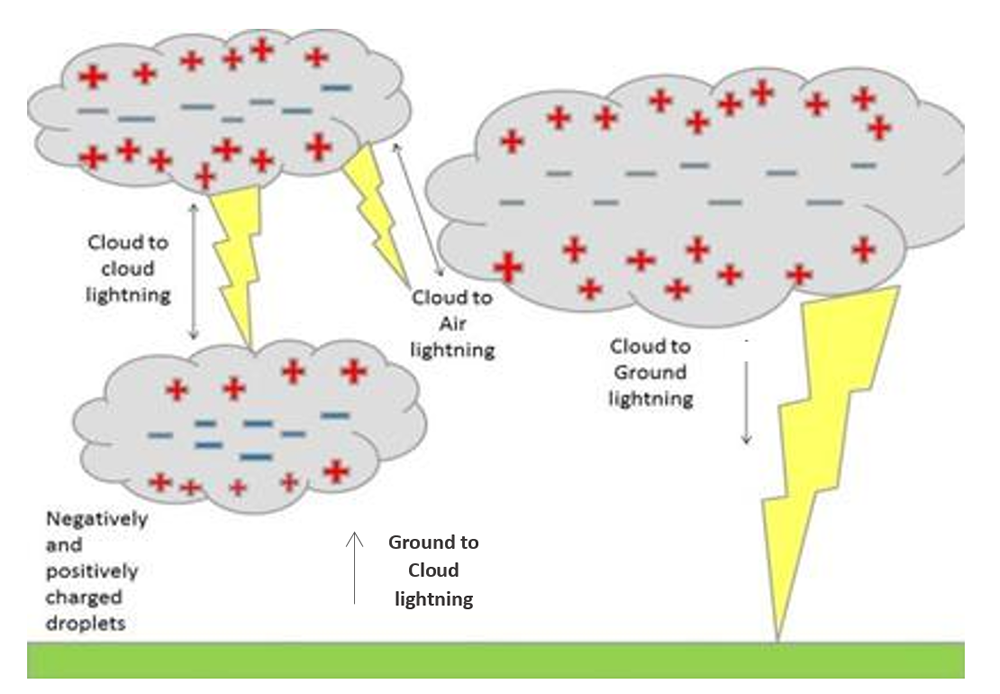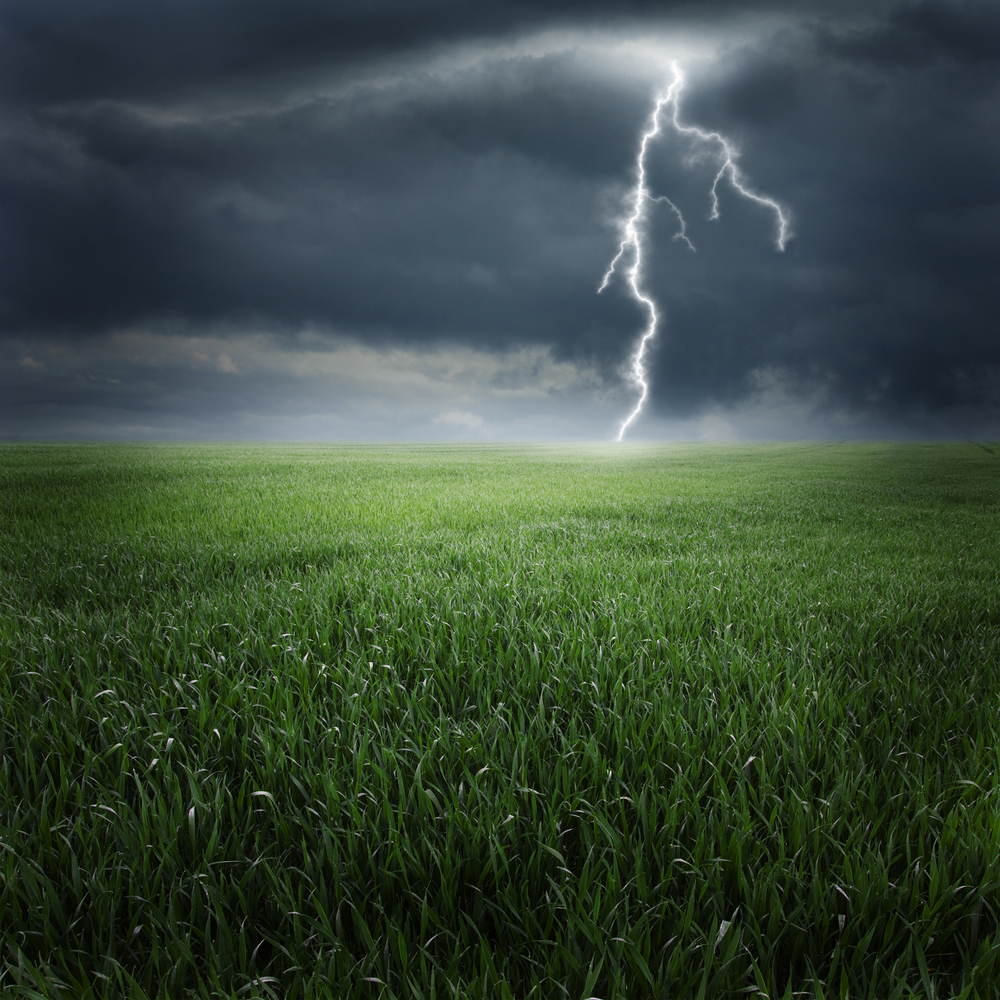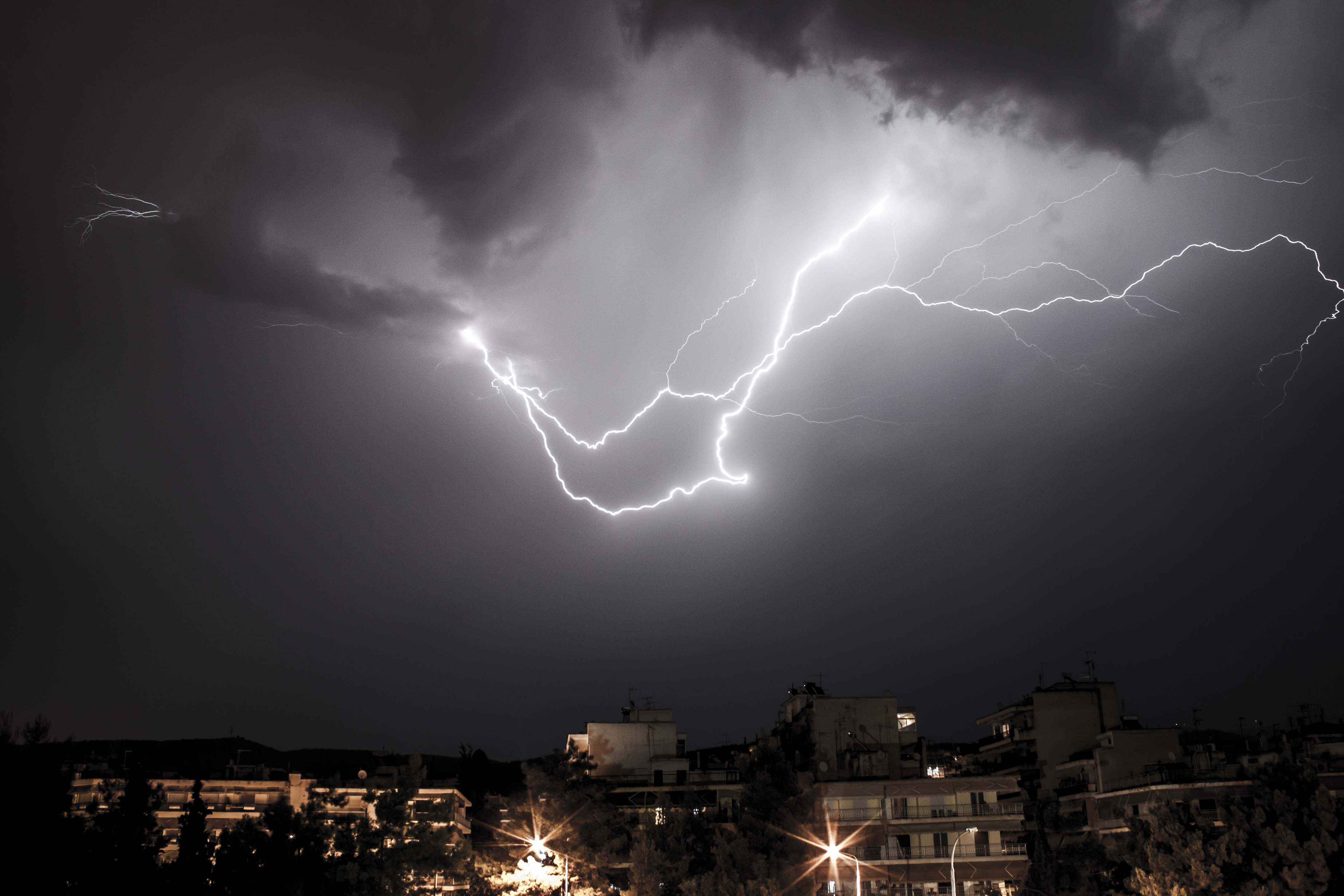why does lightning travel from clouds to the ground
A beautiful and deadly natural phenomenon, lightning is only a sudden, electrostatic discharge - a 'spark' or 'flash' as charged regions in the atmosphere temporarily equalise themselves done this discharge. IT is the polarity of lightning discharge that can buoy affect the way it spreads and branches in space and time. Information technology is this, as well as its starting and ending points, and direction of movement, that give rise to different 'types' of lightning.Lightning bathroom ten-strike the primer coat, the strain, or inside clouds, but there are roughly 5 to 10 times Sir Thomas More fog flashes than there are cloud-to-solid ground flashes.

Cloud-to-Ground (CG) Lightning
In CG lightning, a groove of negative charge, titled a stepped leader, will zigzag downward in a 'forked' pattern - hence it is sometimes called chain lightning. This stepped leader is nonvisual to the human heart, and travels to the ground in a millisecond. As IT nears the ground, the charged stepped loss leader is attracted to a carry of positive charge reaching up, a streamer, ordinarily through something leggy, such as a tree, house, or telephone pole. When the oppositely-live leader and waft connect, a sinewy electrical current begins flowing (hence why IT is ill-advised to stand nether a tall object during a thunderstorm!). A return stroke (the rattling bright visible dash that we see every bit lightning) travels at about 60,000 miles per second back towards the cloud, with one flash consisting of as many as 20 return strokes.
Negative Cloud-to-Ground Lightning (-CG)
The most standard CG flashes are initiated by a downward-moving, negatively-charged stepped leader which is followed by an ascending travelling bring back stroke. The net effect of this swank is to lower berth antagonistic charge from the cloud to the ground. Negative CG lightning strikes can be identified by their distinctive downward branching.

Cocksure Cloud-to-Ground Lightning (+CG)
The less inferior CG flashes are initiated by a downward-moving, positively-charged stepped loss leader which is followed by an upward travelling return stroke that lowers the positive charge to earth. Such lightning is usually associated with supercell thunderstorms and trailing stratiform precipitation regions behind squall lines. Positive cloud-to-ground lightning strikes are typically very bright (relative to other lightning activity) and can exist identified aside their distinct want of branching near the ground. Thunder from so much lightning is very loud and may levelheaded like a series of deep, downhearted-oftenness sonic booms. Sprites (see side box seat) are usually joint with to a greater extent intense confirming Cgs system.
Cloud-to-Air (CA) Lightning
This refers to a discharge that jumps from a cloud into clear air and terminates abruptly – indeed, CG lightning contains Calcium lightning via the branches that offer from the primary channel into the mid-air. However, the most dramatic examples occur when long, bright lightning channels extend from the sides of thundercloud clouds.
Ground-to-Cloud (GC) Lightning
A put down between cloud and ground initiated away an upward-moving drawing card originating from an physical object connected the ground. Ground-to-Cloud lightning strikes - sometimes titled upward-vibrating lightning - are common on tall towers and skyscrapers. Gigahertz lightning give notice also be either positive or negative in polarity. Lightning that demonstrates ascending branching is a crystallise indication of a ground-to-cloud flash, though some upward-moving lightning is branchless under the cloud base.
Intracloud (National Intelligence Community) Lightning
This is the all but common case of expel and refers to lightning embedded within a single storm cloud, which jumps between different charge regions in the cloud.
Tabloid Lightning is a full term used to describe clouds illuminated by a lightning eject where the real lightning channel is either in spite of appearanc the clouds or below the horizon (i.e. non visible to the observer). Although often joint with IC lightning, IT is simply any lightning that is hidden by clouds or terrain aside from the flash of light it produces.
A attached term, heat lightning , is some lightning operating room lightning-induced illumination that is too furthest away for big H to be heard. Stir up lightning got its call because information technology is often seen on hot summer nights, a time when thunderstorms are public.
Cloud-to-Cloud (CC) Lightning (or intercloud lightning)
Although rare, lightning can too travel from one cloud to another (or more!). Spider lightning refers to prospicient, horizontal running flashes a great deal seen along the underside of stratiform clouds. (Non to be confused with intracloud lightning within a single mottle).

Lightning in the UK
The nigh spectacular displays of lightning in the UK are normally associated with "Spanish Plume" typecast events, especially since these can happen during the night. These thunderstorms incline to produce key lightning expected in part to their high cloud bases, which increases the amount of water in frosting form, necessary for strong electrical charging. These high cloud over base storms tend to suffer a greater dimension of IC flashes.
It is winter storms which usually produce the greatest proportion of CG flashes over the UK. Lightning producing clouds are associated with active cold and obstructed fronts, just many are also embedded in the polar maritime breeze mass afterwards (the emblematic wintry showers which regard the western half of the country, producing sibilant hail) and well-marked on the synoptic charts as troughs. Given the comparatively warm sea is the source of instability, these showers potty be present during the day and Nox, and produce infrequent only very muscular CG flashes of up to ~300,000 amps! (typical lightning is ~20kA). The reason for their predetermine towards powerful CG flashes is thought to Be imputable their sheared, low cloud tops. The positive charge at the cover of these clouds overhangs the lower pessimistic charge which would other screen the upper charge from the ground, encouraging a direct, almighty lightning flash between the top of the cloud and the ground.
Sprites, jets and other types of lightning
Sprites are electrical discharges that go on high above alive thunderstorms. Sprites appear American Samoa vertical carmine column extending adequate 60 miles from the cloud top and give been set up to occur in conjunctive with and/or Eastern Samoa a reaction to +CG lightning. Sprites are mostly red, faintly ignited (thus only viewable at Night), and only last a few seconds fashioning them nearly invisible to the naked eye and difficult to photograph. Their shape has been described A resembling columns, carrots or jellyfish!
Blue jets emerge from the top of the thundercloud, extending up in narrow cones fanning out and vanishing at high of 25-35 miles. Jets last just a divide of a moment.
Elves are rapidly expanding harrow-shaped glowing regions that can be adequate 300 miles in diameter. They last to a lesser degree a thousandth of a second, and pass off above areas of active CG lightning. Scientists trust elves result when an energetic magnetic attraction pulse extends up into the ionosphere.
Incus Crawlers are shoetree-comparable, horizontally-blown IC lightning discharges which tend to appear along the bottom of thunderstorm anvils. They can cost seen by the human eye due to their slower speed (relative to former lightning!). This type of lightning (sometimes referred to as 'rocket lightning') often cover very large distances, resulting in spectacular sky-filling displays. Anvil crawlers are often selfsame high-elevation events, and typically result in falling, trilled thunder payable to their great distance from the perceiver. Incus crawlers tin either occur severally completely within the mottle, or in connection with a cloud-to-run aground expelling.
A bolt from the blue (sometimes named 'anvil lightning' or 'anvil-to-ground' lightning) is a name given to a cloud-to-ground lightning drop that strikes FAR away from its parent thunderstorm. It typically originates in the highest regions of a thundercloud cloud, travelling horizontally a good aloofness away from the thunderstorm before qualification a vertical stemma to earth. Attributable the closing strike point existence up to 10 miles away from the storm, these lightning events can fall out at locations with clear 'blue' skies budget items - hence the name. Indeed, this is the origin of the term describing something unplanned: 'come out of the closet of the blue'!
Bead Lightning is the name given to the decaying stage of a lightning channel which cools after a return stroke and its luminance breaks upbound into segments. It describes a stage of a normal lightning discharge kinda than a type of lightning.
Ribbon Lightning occurs in thunderstorms with high get across winds and many return strokes The roll up blows each successive restitution stroke sideways into the previous return stroke causing a ribbon effect (Camera movement during the capture of a lightning photograph can also result in the same impression).
Staccato lightning is a CG lightning hit which is a short-duration stroke that often appears as a respective very bright flash with considerable branching.
And finally, what is ball lightning ...?!
Want to track live lightning strikes across the humanity? Baulk outer this link >>
why does lightning travel from clouds to the ground
Source: https://www.rmets.org/metmatters/types-lightning
Posting Komentar untuk "why does lightning travel from clouds to the ground"